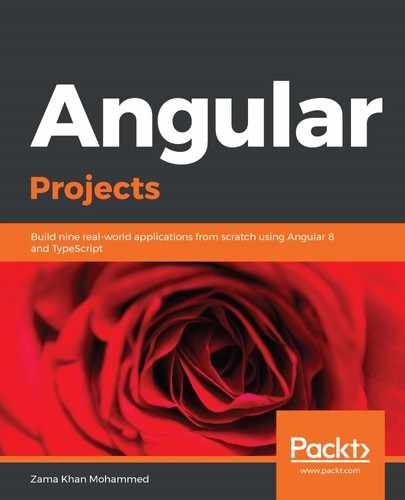Chapter 1, Setting Up the Development Environment, starts off the book by setting up the development environment, and covering the basics of TypeScript, the Angular CLI, and other tools required for this book and for the effective development of Angular applications.
Chapter 2, Building a Flashcard Game Using Angular, is aimed at novice Angular developers, going through basic concepts regarding Angular components, services, and some other fundamental concepts such as important decorators, template-driven forms, observables, and change detection.
Chapter 3, Building a Personal Blog Using Angular Router and WordPress, shows how you can create multi-environment systems, communicate with APIs, create multiple routes, and optimize an application using lazy loaded routes and different prefetching strategies.
Chapter 4, Building an Inventory Application Using Reactive Forms, covers building complex forms using reactive forms and introduces you to using third-party Angular component libraries. We will also learn how to optimize a bundle by first analyzing it and optimizing it if possible.
Chapter 5, Building a PWA E-Commerce Application Using Angular Service Worker, introduces Progressive Web Apps (PWA) and then goes through building an application, adding to PWA capabilities by adding Angular service workers, and other PWA capabilities.
Chapter 6, Building an Auditing Application Using Angular and Ionic, introduces Ionic Framework to build native applications. You will develop apps with Firebase and ngx-formly for real-time communication and creating dynamic JSON forms, respectively.
Chapter 7, Building a Server-Side Rendering Application Using Angular, takes the personal blog app we created and renders it on the server side to optimize the application for performance and search engine optimization.
Chapter 8, Building an Enterprise Portal Using Nx, NgRx, and Redux, introduces you to using Nx to create an enterprise portal as a monorepo application. We will convert an app developed using the Angular CLI, upgrade it to an Nx workspace, add a new admin portal, and use NgRx to handle the whole authentication flow using it. Lastly, we'll use ngx-charts to add D3 visualization.
Chapter 9, Building a Multi-Language NativeScript Application with Angular, goes over creating a native app using NativeScript Angular, introducing the different layouts available, and then using an Angular module and a NativeScript module. The ngx-translate Angular module will allow you to add multiple language support to the application.
Chapter 10, Building a Component Library Using Angular CDK and Elements, teaches how you can create a reusable component library with a component that is accessible by using the Angular CDK and then publish it to npm. You will also learn about Angular elements and how to use them in any JavaScript non-Angular application.
Chapter 11, Testing an Angular Application Using Jasmine, Jest, and Protractor, covers testing strategies a developer can use to test applications and teaches different testing strategies by writing tests for components, services, and pipes. We will also look at how we can mock HTTP calls for Jasmine tests using Jest, snapshot testing, and end-to-end testing, and learn about test coverage and error handling.
